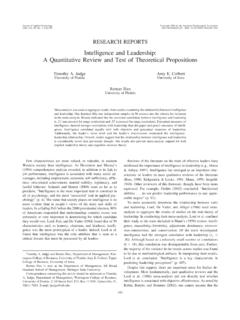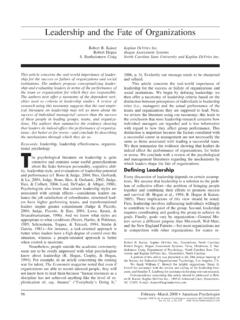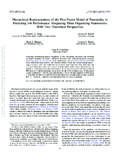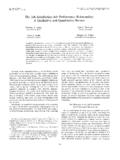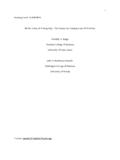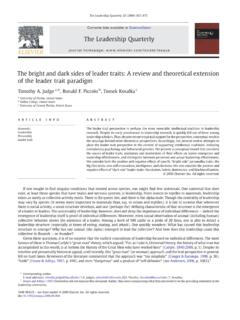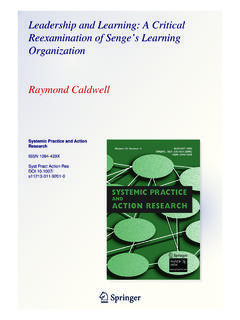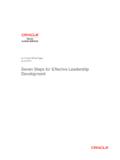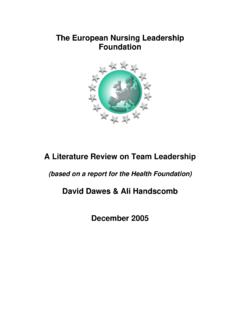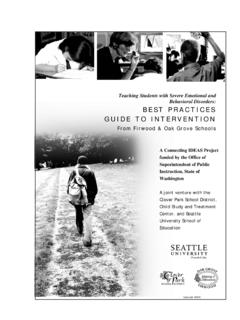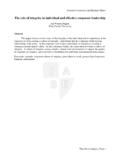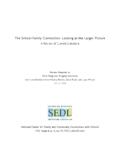Transcription of Loving Yourself Abundantly: Relationship of the ...
1 Loving Yourself abundantly : Relationship of the Narcissistic Personality toSelf- and Other Perceptions of Workplace Deviance, leadership , and Taskand Contextual PerformanceTimothy A. Judge, Jeffery A. LePine, and Bruce L. RichUniversity of FloridaThe authors report results from 2 studies assessing the extent to which narcissism is related to self- andother ratings of leadership , workplace deviance, and task and contextual performance. Study 1 resultsrevealed that narcissism was related to enhanced self-ratings of leadership , even when controlling for theBig Five traits. Study 2 results also revealed that narcissism was related to enhanced leadershipself-perceptions; indeed, whereas narcissism was significantly positively correlated with self-ratings ofleadership, it was significantly negatively related to other ratings of leadership . Study 2 also revealed thatnarcissism was related to more favorable self-ratings of workplace deviance and contextual performancecompared to other (supervisor) ratings.
2 Finally, as hypothesized, narcissism was more strongly negativelyrelated to contextual performance than to task that is lovely in himself he loves,and in his witless way he wants himself:he who approves is equally approved;he seeks, is sought, he burns and he is why, O foolish boy,so vainly catching at this flitting form?The cheat that you are seeking has no your gaze and you will lose your love,for this that holds your eyes is nothing savethe image of Yourself reflected back to comes and waits with you; it has no lifeit will depart if you will only go. Publius Ovidius Naso ( Ovid ) (B. More [trans.])The Greek myth of Narcissus tells the story of a man so vainand proud that he fell in love with his own image. In the fieldof psychology, Freud (1914/1991) used the term narcissism todescribe the Relationship between libido and the ego. Freudconsidered narcissism to result from a perturbed childhoodtransition from subject-directed to other-directed libido, andwas manifested in tendencies to prefer fantasy to reality.
3 SinceFreud s libidinal-based treatment of the concept, psychologistsconsidered narcissism to lie within the domain of clinical psy-chology, though in a manner somewhat different from Freud streatment. According to theDiagnostic and Statistical Manualof Mental Disorders(DSM IV; American Psychiatric Associa-tion, 2000), narcissism is, broadly, a grandiose sense of self-importance. According to theDSM IV, narcissists are preoccu-pied with fantasies of unlimited success, believe they arespecial and unique, require excessive admiration, have a senseof entitlement, are interpersonally exploitive, lack empathy, andare arrogant and haughty. Within the realm of normal psychol-ogy, narcissism came under serious study in the late 1970s andhas since intensified. Some writers have argued that society asa whole has become more narcissistic (Lasch, 1979), whileothers have argued that individuals differ in their narcissisttendencies and such differences could be measured in the nor-mal population (Raskin & Hall, 1981).
4 In personality/social psychology, research has focused on topicssuch as whether narcissism predicts aggression ( , Bushman,Bonacci, van Dijk, & Baumeister, 2003), how narcissists view andare viewed by others ( , Taylor, Lerner, Sherman, Sage, &McDowell, 2003), and the role of narcissism in self-enhancement(Wallace & Baumeister, 2002) and in interpersonal relationships( , Campbell, Foster, & Finkel, 2002). Researchers have distin-guished narcissism from related concepts such as extraversion,hostility, and self-esteem. Of these, perhaps most focal is self-esteem. Research has indicated that narcissism is positively butmoderately related to self-esteem, with the correlation varying byself-esteem measures (r .35 across measures; Brown & Zeigler-Hill, 2004). Campbell, Rudich, and Sedikides (2002) conclude, Narcissism does not appear simply to reflect exceptionally highself-esteem (p.)
5 365).Numerous studies have sought to develop or validate measuresof narcissism. Of the extant measures, the most frequently used isthe Narcissistic Personality Inventory (NPI; Raskin & Hall, 1981).Emmons (1984) investigated the construct validity of the NPI andfound four factors, which he labeled: (1)Exploitiveness/Entitle-ment(the belief that one is adept at manipulating people, and alsoa sense of entitlement to do so); (2) leadership /Authority(thebelief that one possesses an extraordinary ability to influenceothers, and the preference for leadership and authority roles ingeneral); (3)Superiority/Arrogance(the belief that one is just better than others and is a born leader); (4)Self-absorption/Self-admiration(an elevated sense of vanity and the belief that one isspecial). Emmons (1987) and Watson and Biderman (1993) pro-vided additional construct validity evidence on a hierarchical rep-Timothy A.
6 Judge, Jeffery A. LePine, and Bruce L. Rich, Department ofManagement, Warrington College of Business, University of concerning this article should be addressed to TimothyA. Judge, Department of Management, Warrington College of Business,University of Florida, Gainesville, FL 32611-7165. of Applied PsychologyCopyright 2006 by the American Psychological Association2006, Vol. 91, No. 4, 762 7760021-9010/06/$ DOI: of narcissism, whereby the four dimensions also indi-cate a higher-order narcissism the intense interest in narcissism in personality/socialpsychology, one might be quite surprised to find that narcissismhas been studied very little in industrial-organizational (I-O) psy-chology. In fact, of the 4,010 studies identified in the PsycINFO database with narcissism in its keywords or abstract, there were nostudies published in the two flagship I-O journals,Journal ofApplied PsychologyorPersonnel Psychology.
7 However, drawingfrom the extant research in personality/social psychology, wesuggest that narcissism may play an important role in predictingratings of criteria that constitute a large portion of the job perfor-mance domain. In fact, the Relationship between narcissism andratings to performance criteria is likely to be relevant to I-Oscholars and practitioners for two fundamental , because narcissism broadly reflects strong self-admirationand behavioral tendencies which may not be viewed positively byothers (Penney & Spector, 2002), it is possible that narcissisminfluences self- and other perceptions differently, and insight intothis possibility may be important given that differences in percep-tions are the foundation for certain types of performance manage-ment and development practices (Brett & Atwater, 2001). Inessence, narcissism may provide an explanation for differences inthe way we perceive our behavior relative to the way others see ourbehavior, and this explanation is different than what is assumed byscholars who may attribute differences to a number of factorsincluding the amount of information available to the rater regard-ing the behavior being rated, a general self-serving bias, attributionprocesses, or differences in understanding regarding the value ofcertain behaviors to the organization (Murphy & Cleveland, 1995).
8 To date, however, there has been no research published (in anyjournal in the PsycINFO database) that compares the influence ofnarcissism with both self- and other ratings of job performancecriteria. Thus, one purpose of our research is to investigate rela-tionships between narcissism and self- and other ratings of jobperformance , we suggest that narcissism may have value as a pre-dictor of job performance criteria over and above other well-known personality traits. Although relationships between the BigFive traits and job criteria such as leadership (Judge, Bono, Ilies,& Gerhardt, 2002), contextual performance or citizenship behav-iors (Organ & Ryan, 1995), and job performance (Barrick &Mount, 1991) are well established, narcissism is an aspect ofpersonality that is not reflected well in the Big Five (Paulhus &Williams, 2002). Moreover, narcissism reflects a set of attitudes,beliefs, and behavioral tendencies that likely impact each of theseorganizational criteria in unique ways.
9 To date, however, only afew studies have even linked narcissism to these criteria. Excep-tions include Deluga (1997) who linked narcissism to the per-ceived greatness of presidents and Penney and Spector (2002)who linked narcissism to self-reported counterproductive behav-iors. As another example, Soyer, Rovenpor, and Kopelman (1999)found a nonsignificant Relationship between narcissism and self-reported sales performance. Thus, a second purpose of our re-search is to investigate the degree to which narcissism predicts jobperformance criteria over and above the Big Five continuing, we note that our choice of performancecriteria was guided by research on multidimensional models of jobperformance, which include leadership , workplace deviance, con-textual performance, and task performance (Borman & Brush,1993; Campbell, 1990; Rotundo & Sackett, 2002). Traditionally,leadershiphas constituted an aspect of performance in jobs thatincluded explicit accountability for the performance of a collective(group, team, organization) or unit of work.
10 However, the chang-ing nature of the workforce ( , increased diversity) and of thenature of work itself ( , increased use of teams) have increasedthe prevalence of leadership as an aspect of job performance(Lord & Smith, 1999). Elements ofworkplace deviance(or coun-terproductive performance), defined as voluntary behavior thatharms the well-being of the organization (Rotundo & Sackett,2002), have been included as aspects of job performance byseveral scholars ( , Murphy, 1989; Robinson & Bennett, 1995).In fact, recent research suggests that managers weigh devianceas much or more than performance of specific job duties whencompleting overall performance evaluations (Rotundo & Sackett,2002).Contextual performanceincludes those behaviors that con-tribute to the organization by fostering a positive social and psy-chological climate (Borman & Motowidlo, 1997). Examples ofcontextual performance include assisting coworkers when theyneed it, being courteous and respectful to peers, making construc-tive suggestions, being a good sport, and putting forth extra efforton the job.
